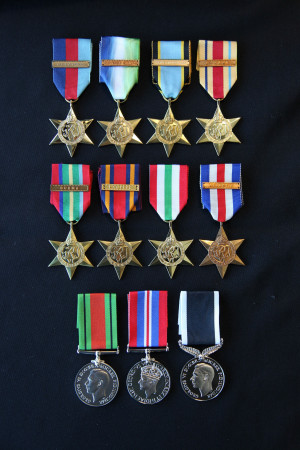NZDF research reveals thousands of Second World War campaign medals were never claimed by veterans
NZDF research reveals thousands of Second World War campaign medals were never claimed by veterans
For the first time since the 1950s, in-depth research has been carried out into how many Second World War campaign medals awarded to ex-serving New Zealand veterans were never claimed, and what may have led to this.
Recent media publicity has highlighted that approximately 15 percent of the Second World War campaign medals awarded to members of 28 (Maori) Battalion were never issued.
Read the full report by Matthew Buck [PDF, 7.6 MB]
New research undertaken by New Zealand Defence Force (NZDF) historian Matthew Buck reveals there was a low rate of uptake of medals by Army and Air Force veterans from across the New Zealand armed forces and those of other Commonwealth countries.

New Zealand Defence Force historian Matthew Buck
“According to my research, around 75 percent of New Zealand Army and Royal New Zealand Air Force veterans refused to apply for their Second World War campaign medals in the first few years after distribution began in March 1950."
“Given the importance placed on medals today, it’s hard to fathom that only around a quarter of New Zealand Army and Royal New Zealand Air Force veterans claimed their medals by 1960. After that the take-up appears to have been nothing more than a dribble - less than a third of a percent annually,” said Mr Buck.
There were only two exceptions to the pattern of low uptake uncovered by this research. They were Royal New Zealand Navy veterans, who received a special “Naval Prize Money” payment of £5 10s if they applied for their medals; and the families of the nearly 12,000 New Zealanders who died in the war, who received their medals automatically in the mail.
We don’t know exactly how many Army and Air Force medals remain unissued because there were no general surveys of the rate of uptake after 1960. If this rate was similar to that of 28 (Maori) Battalion, however, we estimate around 22,000 New Zealanders who served overseas during the war may never have been issued their medals.
“The main reasons given by veterans for not claiming their medals were that, unlike First World War veterans, they were required to apply for them and the medals were issued without their names, ranks and service numbers engraved on them. Many felt that this made their medals valueless,” said Mr Buck.
“Most complaints from New Zealand veterans centred around having to go ‘cap in hand’ for something they’d earned, which they felt should have been awarded to them as of right. There was also a perception that it was vainglorious to apply for your medals.
“Others expressed the view that there were too many medals, and that they were awarded far too widely and to groups who they considered undeserving.”

The 11 Second World War campaign stars and medals (including seven of the nine possible clasps) that could be claimed by New Zealand veterans in 1950. Left to right and top to bottom: 1939 ̶ 1945 Star (Clasp: Battle of Britain); Atlantic Star (Clasp: Air Crew Europe); Air Crew Europe Star (Clasp: France and Germany); Africa Star (Clasp: 8th Army); Pacific Star (Clasp: Burma); Burma Star (Clasp: Pacific); Italy Star; France and Germany Star (Clasp: Atlantic); Defence Medal; War Medal 1939 ̶ 1945; and New Zealand War Service Medal. Individuals could receive either a star or a clasp of the same name, but not both.
Mr Buck notes that, by comparison, there was an almost 100 percent uptake of war service gratuity payments, which in some cases could amount to the money needed for a house deposit.
The Government of the time adopted its course of action because of the sheer number of medals, and a five-year delay between the end of the war and the delivery of medals to New Zealand.
“It was estimated in 1950 that engraving all the medals would take six years. By this stage, moreover, the Government had become convinced that the low take-up of medals elsewhere in the Commonwealth showed that engraving the medals would do little to persuade veterans to apply for them,” said Mr Buck.
Defence Historian John Crawford notes that the response should not be seen as surprising.
“By the early 1950s the Second World War was well over, and authorities were very focused on the war in Korea and the risk of it escalating. Those who had served were generally young men, now well established in civilian life with young families. Their military service was well behind them and they were past being told what to do by the military,” said Mr Crawford.
“For many of these men there had been no glamour in what they had been through, with horrific and brutal memories and lost friends. Moreover, everyone had served. They knew what their neighbours and friends had done in the war and they didn’t need medals to know that.”
Mr Crawford said that, three generations later, perceptions around the medals have changed and it is important they are claimed.
“They are no longer a statement of service to their peers, but rather a tangible connection to a group of men and women who have all but passed. The medals help keep alive their memory, encourage families to learn more, share their stories and wear the medals with pride.”
The NZDF Personnel Archives and Medals team encourages families to enquire about whether medals have been issued. The team routinely checks for outstanding medallic entitlements whenever information is requested from a personal file.
Read the full report by Matthew Buck [PDF, 7.6 MB]